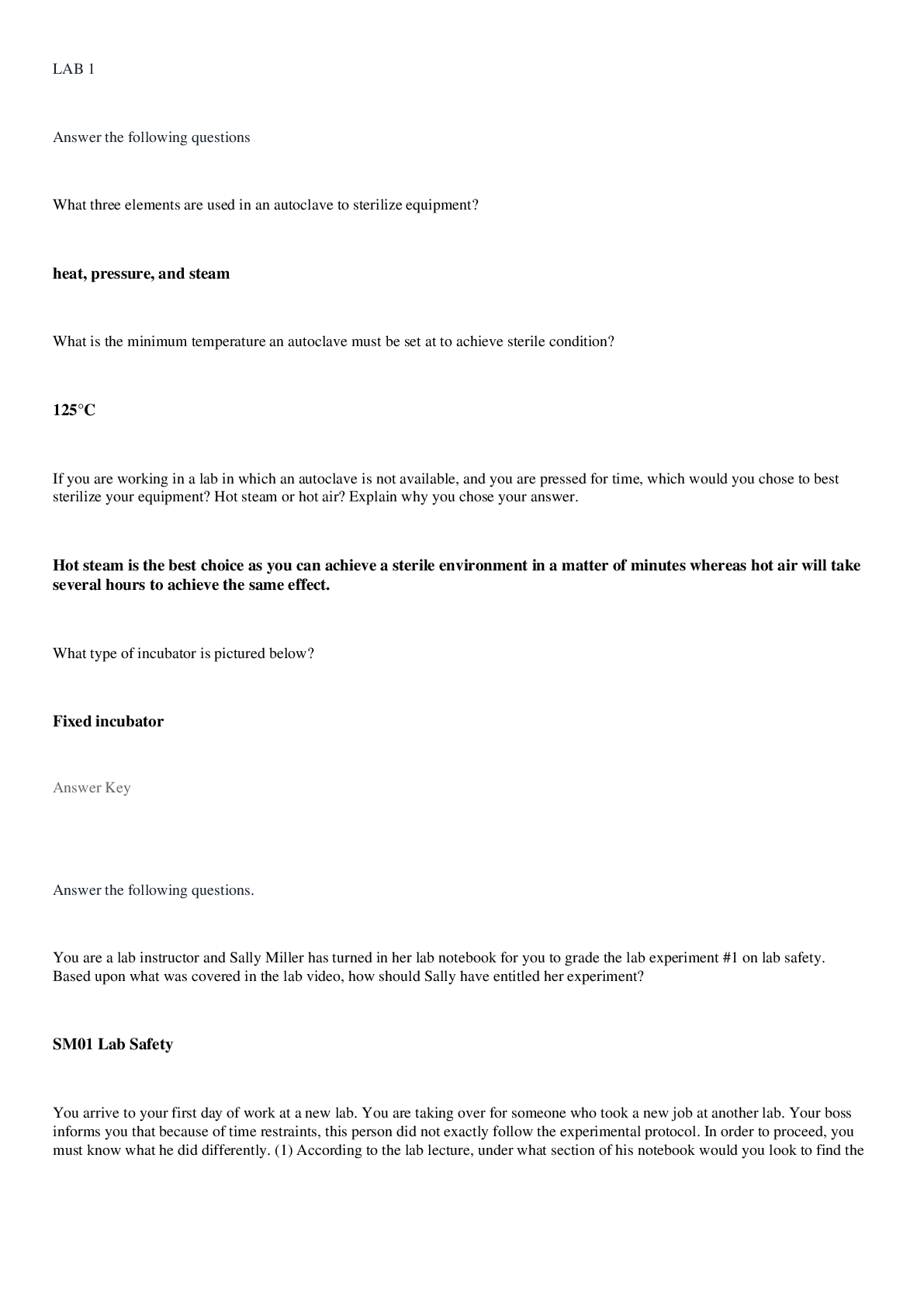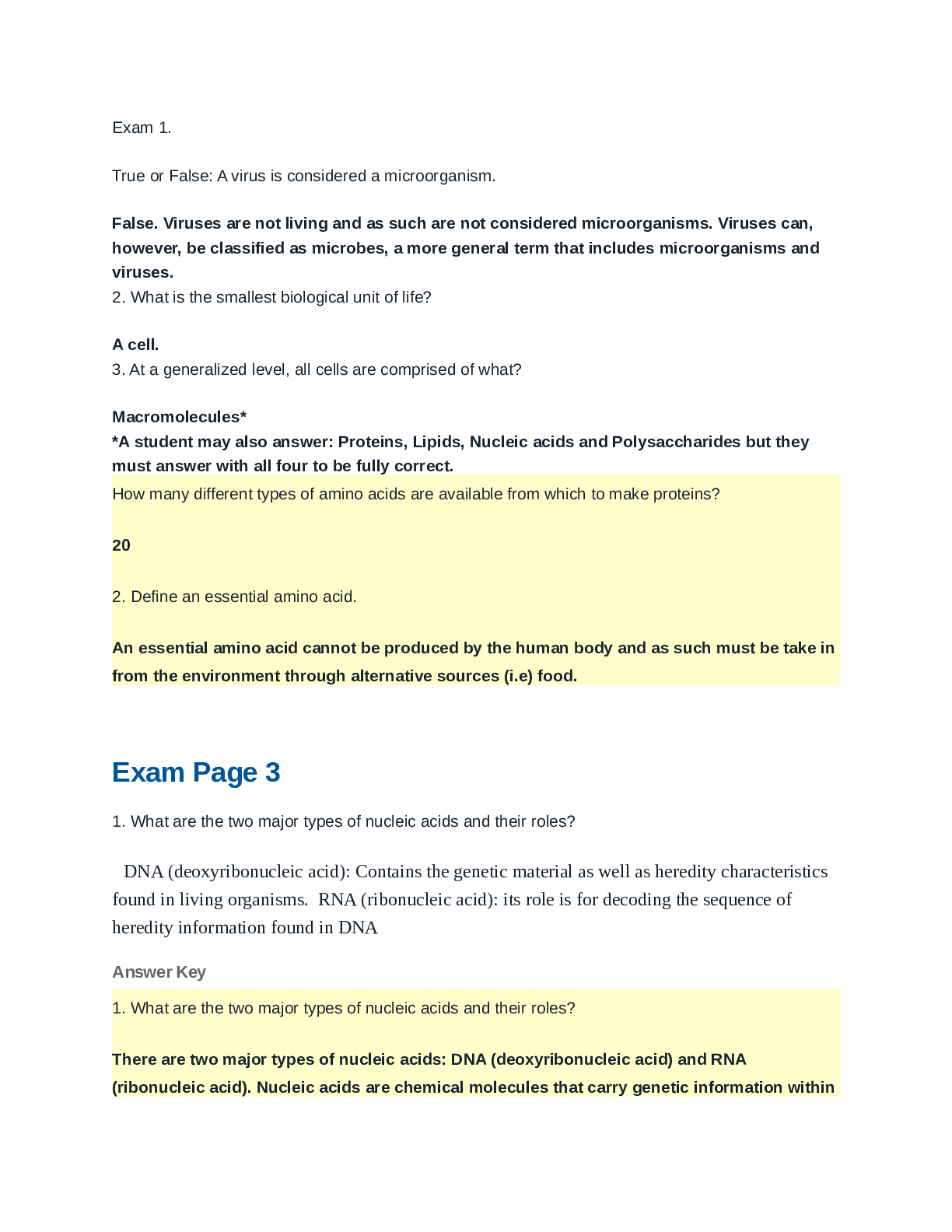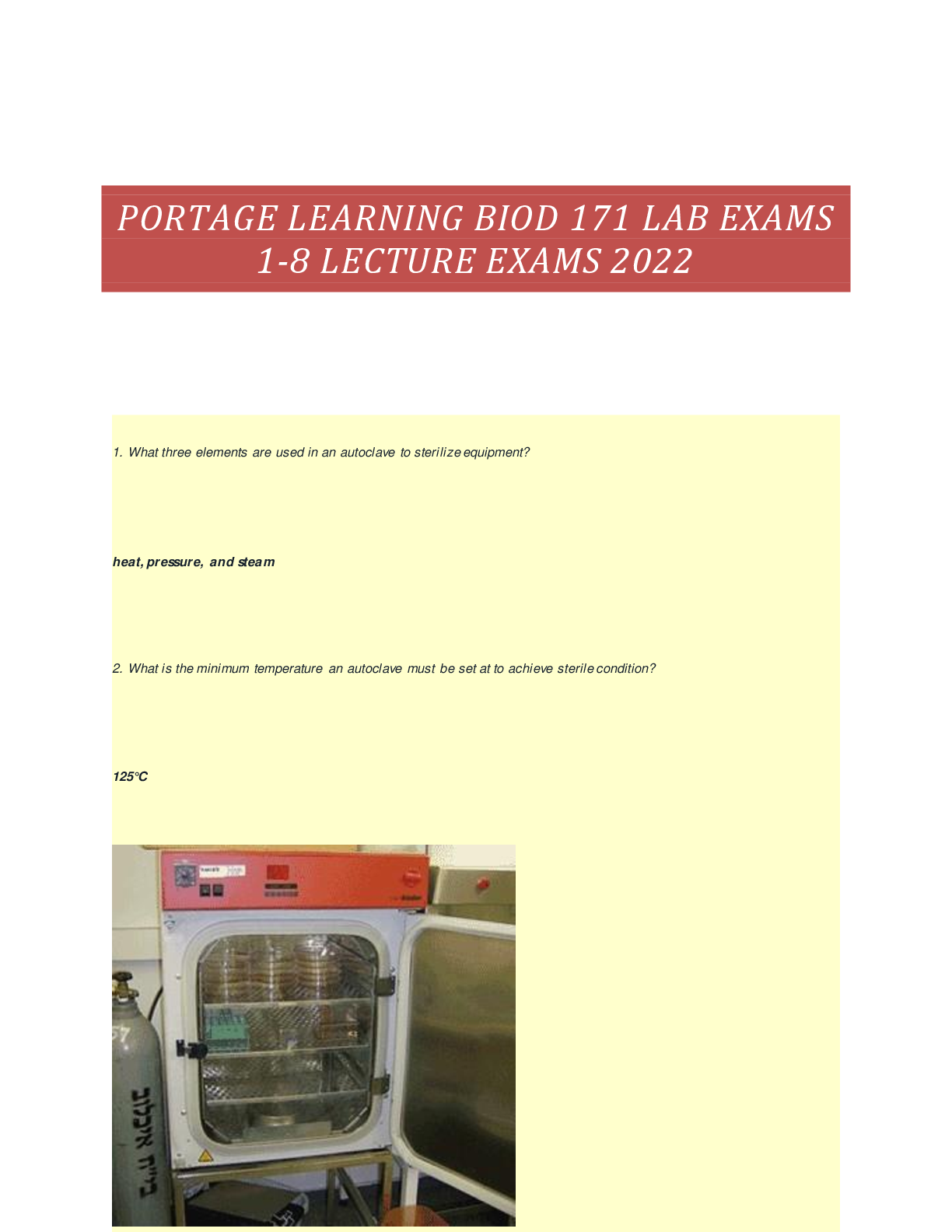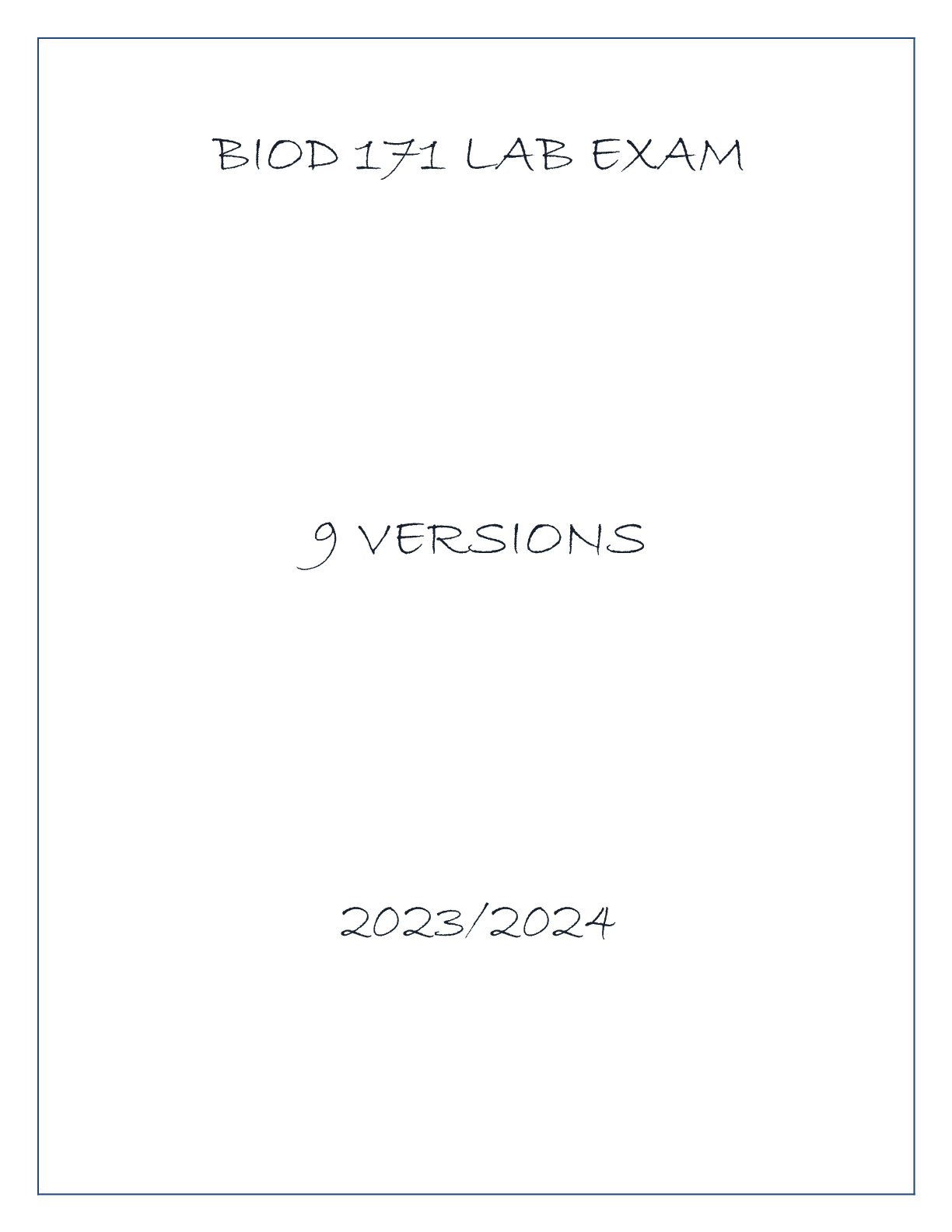Micro Biology > EXAM > Portage Learning BIOD 171 Lab Exams 1-8 (100% CORRECT ANSWERS) (All)
Portage Learning BIOD 171 Lab Exams 1-8 (100% CORRECT ANSWERS)
Document Content and Description Below
Lecture Exams Answer the following questions. 1. At what temperature is the fixed incubator set to, as presented in the lab video? 37°C 2. At what temperature should you re... frigerate bacterial samples? Explain why this is beneficial. 4°C. This temperature slows bacterial growth and prolongs the life of the sample. 3. What are the FOUR types of gloves presented in the lab video? Latex, Nitrile, Thermal cold, Thermal heat 4. What THREE rules were discussed in regards to lab safety that would protect you and others from contamination? 1. Never eat or drink in the lab 2. Always wear appropriate PPE 3. Never leave the lab wearing PPE 5. What are the main sections that should be found in a lab notebook? Name at least 4. Objective, Procedure, Notes, Results and Deviations Answer the following questions. 1. You are a lab instructor and Paul Smith has turned in his lab notebook for you to grade the lab experiment #2 on microscopy. Based upon what was covered in the lab video, how should Paul have entitled his lab experiment? PS02 Microscopy 2. You arrive to your first day of work at a new lab. You are taking over for someone who took a new job at another lab. Your boss informs you that because of time restraints, this person did not exactly follow the experimental protocol. In order to proceed, you must know what he did differently. (1) According to the lab lecture, under what section of his notebook would you look to find the experimental steps? (2) As changes to the experimental steps were made, what are these differences called and how should it appear in the lab notebook? (1) Procedure—this is where the steps for the experimental protocol are recorded. (2) Deviations. All deviations should be written in red to immediately bring attention to the changes in the protocol. Answer the following questions 1. Identify the part of the microscope indicated by the arrow. Neck (or arm) 2. Identify the part of the microscope indicated by the arrow. Stage 3. Identify the part of the microscope indicated by the arrow. fine focus Answer the following questions 1. You are about to study a bacterial sample under a light microscope. You look into the oculars and see two circles. What adjustments need to be made? Compress or expand the oculars until a single circle can be seen while using both eyes simultaneously. 2. What 2 parts of the microscope contributes to the total magnification to your sample? Objective and oculars (eyepiece) 3. As you looking through the microscope you wish to dim (or limit) the amount of light entering into the eyepiece—what component of the microscope other than the light source itself can be adjusted to make these modifications? Diaphragm Answer the following questions 1. What objective power is best suited if you are uncertain what the sample is and where to begin? 4x (or lowest power objective) 2. You are viewing a sample of bacteria that is 3 mm in diameter through a 40x objective lens. The eyepiece has a magnification power of 10x. What size will the sample appear through the eyepiece? 1200 mm in diameter (or 400x’s larger) 3. Based on the microscope shown in the lab lecture, which objectives would NOT require placing oil on the slide? 4x, 10x and 40x Answer the following questions. 1. List the 4 main steps used to prepare a WET mount and indicate which (if any) step is optional. 1 – Clean slide 2 – Circle area on slide with wax/hydrophobic pen 3 – Apply organism to slide 4 – View under microscope *Note: there are no optional steps in the wet mount. 2. When preparing a glass slide for a dry mount, what cleaning solution was used? 70% ethanol 3. You wish to study the motility of a particular bacterium. What type of mounting technique would you use? Explain your answer. A wet mount technique is the best technique to use when studying motility of an organism because the sample remains viable (heat fixing kills the sample). 4. What dye do Gram-negative bacteria primarily retain? Safranin Answer the following questions. 1. Why do Gram-negative bacteria stain red? Gram-negative bacteria have a thin peptidoglycan layer in their cell wall. During the alcohol rinse step, the cell wall cannot retain the crystal violet dye. It will be washed away. The cell wall will then absorb the counter stain, safranin. 2. Identify the stain and shape of the bacteria pictured below. Gram-positive; Cocci (spherical) 3. When might you want to utilize a negative stain technique in the lab? What is the name of the primary dye used in this technique? A negative stain is used to identify organisms with an opaque structure. Nigrosin dye. 4. Why do bacteria repel the dye nigrosin? Nigrosin is a negatively charged dye. The membranes of most cells are also negatively charged. The membrane will repel the dye not allowing it to be absorbed. Answer the following questions. 1. When performing a Gram stain, what is the purpose of the heat fixation step? Heat fixing removes all traces of moisture and ‘fixes’ (sticks) the sample tightly to the glass slide. 2. What is the proper way to dispose of all materials used during the lab? All materials must be place in a biohazardous waste bag and placed into an autoclave for sterilization. 3. What are the Gram status, shape and identification of organism #1 from the Gram stain procedure? Gram-positive; Cocci (spherical) clusters; Staph aureus 4. What are the Gram status, shape and identification of organism #4 from the Gram stain procedure? Gram-negative; Bacillus (rod); Pseudomonas Answer the following questions. 1. You are looking for media that will help you distinguish between two gram positive bacteria. What type of media would be best for this? Differential media 2. If you were to remove the red bloods cells from at blood agar plate (BAP) what kind of agar plate derivative would you have? TSAYE (Tryptic soy agar yeast extract) 3. Identify the selective and differential media known for its metallic sheen shown below. EMB (Eosin Methylene Blue) Answer the following questions. 1. What type of bacteria does Sorbitol MacConkey agar select for? Gram-negative bacteria 2. Eosin Methylene Blue (EMB) agar is: A. Selective media B. Differential media C. Selective and differential media D. None of the above C 3. What pathogen is best identified using a SMAC agar? E coli O157:H7. SMAC agar specifically differentiates between non-pathogenic E coli and the pathogenic E coli strain O157:H7. 4. What plating method is used to isolate a single bacteria colony? 4-phase dilution streak 5. What plating method is used to grow multiple types of bacterial colonies? Quadrant growth method Answer the following questions. 1. Based on the 4-phase dilution streaking experiment, in what phase were bacterial isolates (colonies) observed? Individual colonies were observed within Phase 3. 2. Identify the plating method (below) as demonstrated in the lab. Quadrant growth 3. Identify the organism growing on the TOP half of the agar and describe the observed hemolytic properties. Staph Aureus; Beta hemolysis is observed based on the zones of clearing within the red agar. 4. Would you expect to see a color change when pseudomonas is streaked onto an EMB agar plate? Explain your answer. No. There would not be a color change because pseudomonas does not ferment lactose. Answer the following questions 1. The Kirby-Bauer method for examining antibiotic sensitivity is also known as what? The Standardized Disc Susceptibility Test 2. True or False. The antibiotic discs are placed onto the LB agar plate before spreading the bacterial culture on the plate. False. The antibiotic discs are place onto the plate AFTER the culture has been spread. 3. When performing the Kirby-Bauer method the areas of clearing surrounding an antibiotic disc after an overnight incubation are known as what? Zones of Inhibition. Answer the following questions 1. Why was an LB agar plate used to test the Staph culture as opposed to a selective/differential agar that only grows Staph? LB agar is used as it simply provides the nutritional requirements to encourage bacterial growth. Since the results of the Kirby Bauer method is directly based on bacterial growth patterns, no other selective or differential additives should be present that may hinder or inhibit the samples growth. 2. What unit of measurement is used when determining the size of the zones of inhibition? A. Centimeters B. Micrometer C. Millimeters D. Meters C 3. True or False. In order to maintain proper spacing the antibiotic discs should be placed approximately a fingers width from the edge of the plate. True. The disc should be placed approximately a fingers width from the edge so that a uniform zone of inhibition can be seen around the entire disc. Answer the following questions 1. Given the following image, determine whether the bacterial sample is resistant or susceptible to the following antibiotics. A—24mm (because radius is given) Susceptible B—9mm Susceptible, despite small zone of inhibition. C—14mm Resistant This page is here for the instructor to grade your lab notebook. Each lab notebook is worth up to 5 points. The grade for your notebook will show on this page once your instructor has finished grading your lab. Please indicate below that you have finished your lab notebook by entering your name in the answer blank. I have finished my lab notebook for this lab: Lab Notebook 5 PL05 Testing bacteria for antibiotic sensitivity Objective: To determine the threshold of antibiotic sensitivity across bacterial strains using the Kirby-Bauer method. (Aka Standardized Disc Susceptibility Test) Procedure: 1. Streak bacteria A across an LB agar plate for confluent growth using a sterile L-spreader 2. Evenly place the paper antibiotic discs on the plate 3. Invert plate and incubate at 37°C overnight 4. Measure zones of inhibition (diameter) 5. Compare results with sensitivity chart Results: - List diameter of zone of inhibition for each disc - Reference chart to determine sensitivity level: Resistant > Intermediate > Susceptible Recorded measurements (optional) Antibiotic Measurements (mm) Vancomycin 30 Clindamycin 16 Oxacillin 17 Tobramycin 22 Erythromycin 24 Penicillin 36 Gentamicin 10 Cefazolin 19 Answer the following questions 1. True or False. The presence of cytochrome C is often associated with aerobic bacteria. True 2. Which STD is most often identified using the Oxidase test? Gonorrhea 3. Using the catalase test, a Staphylococcus sample would be: A. Gram (+), Catalase (+) B. Gram (-) Catalase (+) C. Gram (-), Catalase (-) D. Gram (+), Catalase (-) A. Gram-positive, Catalase-positive. 4. True or False. The catalase test is a qualitative and selective assay. False. The catalase test is a qualitative and differential assay. Answer the following questions 1. Fibrin is another term for ? blood clots 2. Once you inoculate the rabbit plasma containing media for the coagulase test, how long do you wait to read the sample results? A. 1-2 hours B. 3-6 hours C. 8-10 hours D. 12-14 hours D. 12-14 hours which is the equivalent of an overnight incubation. 3. How is fibrin beneficial to a bacterium in terms of antibody recognition? The presence of fibrin can form a ‘hard’ shell (or coat) around the bacterium, making antibody binding difficult. If antibodies are unable to bind, the bacterium can escape immune detection. 4. The hydrolysis of triglycerides on a spirit blue agar plate most closely resembles that of hemolysis on a blood agar plate. A. Gamma B. Beta C. Alpha D. None of the above. B. Beta. 5. As stated in the lab video, an example of a lipase-positive bacterium is: A. Staph aureus B. Pseudomonas C. Bacillus subtilis D. Streptococcus C. Bacillus subtilis Answer the following. An unknown bacterium (Sample A) was tested using several of the rapid, qualitative tests described within this lab lecture. Using the images of the results below indicate the lab results for each test (1-3) as either positive or negative, then using the decision tree identify the unknown bacterium by the corresponding letter. The unknown sample is: Oxidase-positive (aerobic), catalase negative and coagulase-positive, which on the decision tree, corresponds with the letter C. Answer the following questions 1. In order to assess a liquid bacterial culture for tryptophan breakdown, ~5 drops of reagent is added. Kovac’s 2. How would a microorganism be classified (positive or negative) if a pink/red band was observed at the top of a liquid culture containing tryptophan? Positive. The microorganism is capable of breaking down tryptophan into indole and would thus be classified as indole positive. 3. Name one advantage that the ability to breakdown tryptophan brings to a microorganism. An increased resistance to drugs/medications OR an increased ability to survive harsh environments—often seen via spore formation. Answer the following questions 1. An enzymatic test that assesses the ability of a microorganism to produce hydrogen sulfide gas and/or ferment sugar is known as the test. TSI (triple sugar iron) test. 2. What color(s) was the TSI agar slant containing Salmonella? Yellow and Black. The agar slant was yellow at the bottom while black on the sloped gradient portion of the agar. 3. Enteric bacteria are often found where? Give an example of one. Enteric bacteria around found in either the intestines or gut. Examples given in the video were either Salmonella or Shigella. Answer the following questions 1. According to the lab module, which 5 wells of the API strip should be layered with mineral oil? ADH, LDC, ODC, H2S and URE 2. How many milliliters of water were added to the tray prior to incubating the strip at 37C overnight? S2: 2206002 Answer the following questions 1. In a Western blot are separated based on its size. proteins 2. When setting up a western blot, what is the purpose of the blocking step post-transfer? Blocking prevents non-specific binding of the antibody—you only want the antibody to bind to its specific target. 3. When developing a western blot what two factors influence the intensity of the band? Both the amount of protein loaded as well as the duration (time) of development is directly proportional to band intensity. 4. Identify (specific name) given to the region of the western blot indicated by the arrow. The arrow is pointing to the dye front. Answer the following questions 1. What is the common name for agglutination? Clumping 2. In the wet lab portion of the video, what pathogen was the agglutination assay specifically designed to test for? Choose all that apply. A. E coli B. Salmonella C. Staph D. Strep C. Staph 3. What was the purpose of the first quadrant of the agglutination assay containing only the reagent? The first quadrant served as the reagent only negative control—you want to ensure the reagent by itself does not clump but rather requires the presence of Staph. 4. Based on the image below, which row (A or B) is negative for agglutination? Row A is negative for agglutination. 5. A patient with type O blood is sent to the lab for a blood-clotting assessment. Since type O blood contains no antigens, which quadrant (#1-6) best depicts the result you would expect to see once the assay is complete? Quadrant 6 shows no signs of agglutination, which is only possible in the presence of antigens. Since Type O blood has no antigens, no clumping will occur during the test. Note: Quadrant 2 was stated to have clumping (albeit minimal) during the wet lab and is thus not an acceptable answer. [Show More]
Last updated: 1 year ago
Preview 1 out of 18 pages
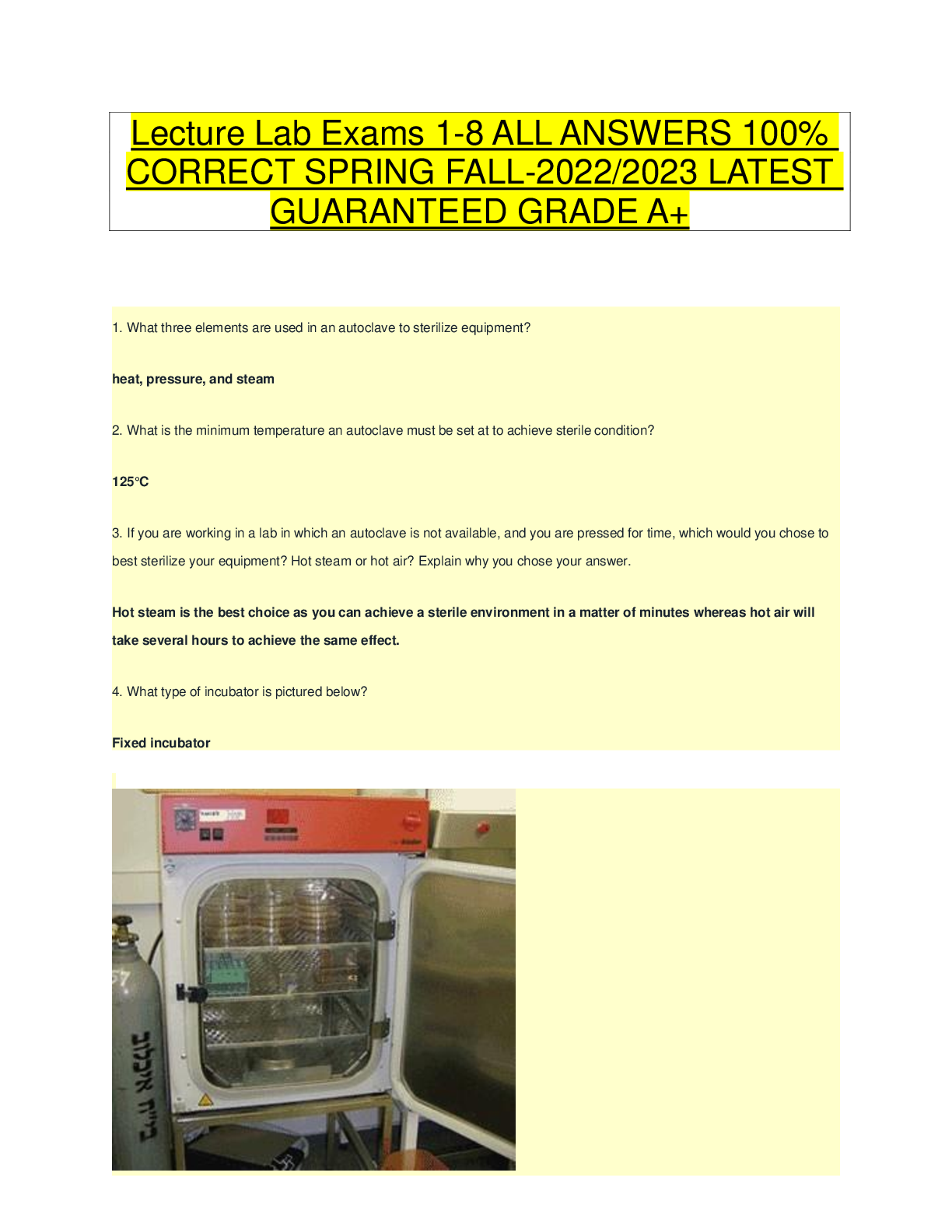
Reviews( 0 )
Document information
Connected school, study & course
About the document
Uploaded On
Jun 22, 2022
Number of pages
18
Written in
Additional information
This document has been written for:
Uploaded
Jun 22, 2022
Downloads
0
Views
27




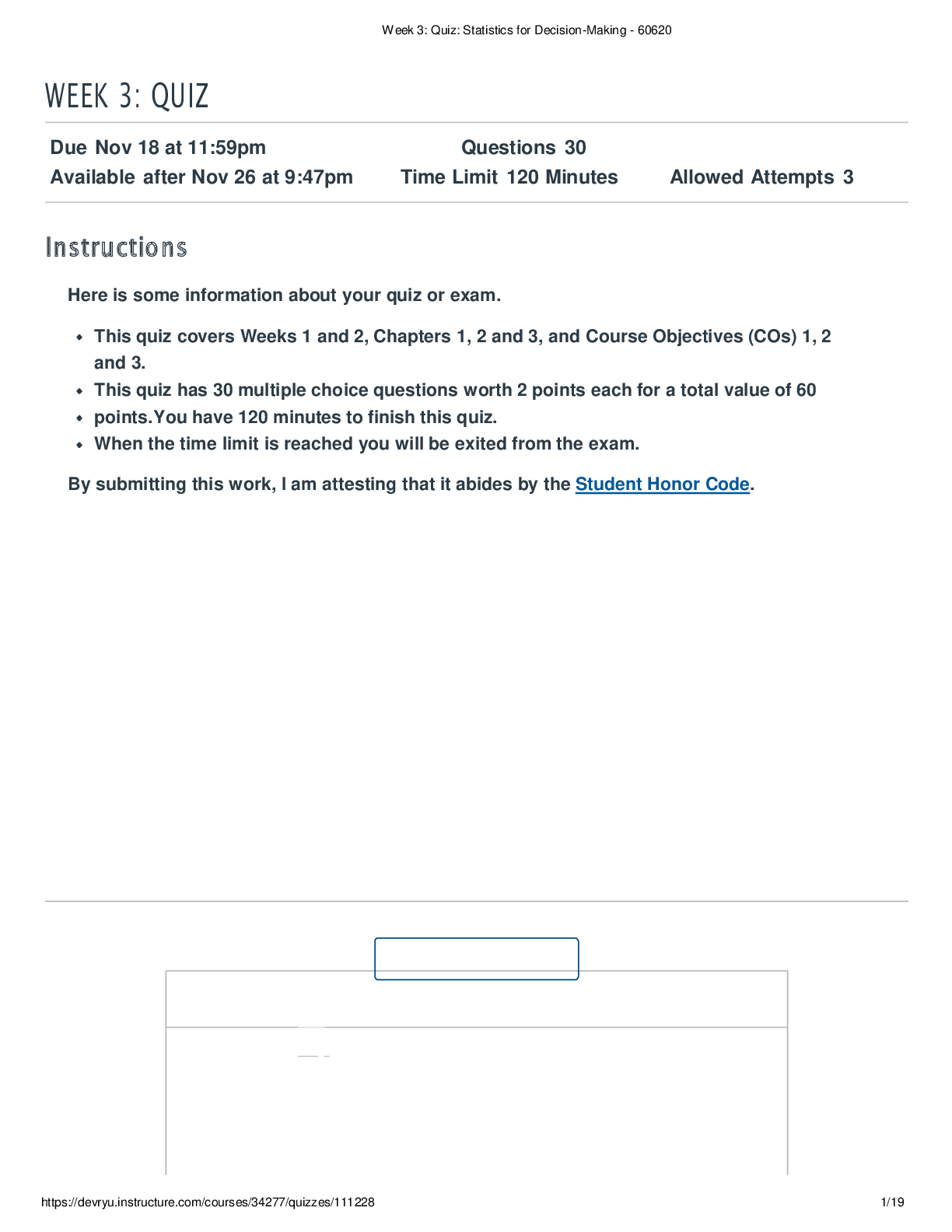

.png)










